
|
|
Rafal T. Prinke - Hermetic HeraldryArticle originally published in The Hermetic Journal, 1989, 62-78.
HERMETIC HERALDRY

Studies devoted to hermetic symbolism seldom touch upon its connections with heraldry though it seems that they should be obvious even to someone with quite limited knowledge of both systems of symbolism. The only works on this area of mutual influence between hermetism and heraldry I could find are in French and include L'hermetisme dans l'art heraldique by F. Cadet de Gassicourt and Du Roure de Paulir (Paris, 1907, reprinted in Les origines symboliques du blason by Robert Viel, Paris, 1972) and Le langage secret du blason by Gerard de Sorval (Paris, 1981). Touching upon the problem are also De sable et d'or. Symbolique heraldique. L'honreur du nom by Christian Jacq and Patrice de la Perriere (Paris, 1976) and Initiation chevaleresque et initiation royale dans la spiritualite chretienne by Gerard de Serval (1985). Even though they are interesting and make a number of valuable observations, they lack a systematic approach to the subject and their conclusions are rather overenthusiastic and tend to be more esoteric than scholarly. In my opinion the problem should be divided into two separate areas of research, namely: 1. HERMETIC HERALDRY which includes (a) the influence of early hermetic ideas on the developement of the heraldic system of coat-of-arms symbolism and (b) the conscious use of hermetic symbols and emblems in later heraldic designs in order to show the owner's interests or make the arms "speak". 2. HERALDIC HERMETISM which includes the use of highly structured symbolic language of heraldry in hermetic iconography. It may sometimes be difficult to differentiate between the two, of course, as they were often used simultaneously but the division may still be useful for methodological purposes. European heraldry, as we know it, is the creation of the chivalric society of the early 12th century and therefore it is obvious that if any hermetic symbolism can be discerned in it, it must have preceded heraldry itself and not the other way round. This is not, however, as simple as it may seem because there is hardly any hermetic iconography from the times preceding heraldic iconography. All comparisons, therefore, have to be made between much later examples and from the 14th century onwards there was certainly much lateral influence between heraldic and hermetic art that makes the whole problem still more complicated.
The authors who have studied the impact of hermetic symbolism on heraldry tend to see its developement like this: 
I would argue, however, that both hermetic and heraldic symbolism developed simultaneously, taking from the same sources and influencing each other, which may be shown thus: 
The influence of bestiaries, the books describing virtues and vices of various animals, including the mythical ones, is obvious in all later European systems of symbolic expression and thus cannot be questioned. It is interesting, however, that some animals are almost exclusively heraldic and hermetic symbols. While such creatures as the dove or the lion are often found in symbolic and alegorical pictures, the eagle seems to be absent from them but is one of the most important symbol of both heraldry and hermetism. Christian symbols are quite common in both systems, so do not need special emphasis. The obvious examples are the four kerubic creatures (lion, eagle, bull, man), the dove, the lamb, etc. Traditional symbolism, mentioned above, is meant to include ancient and Arab sources which are of greatest interest here. First of all the colours and their correspondences must be mentioned, as crucial to heraldry and also very important in hermetic theory and art. The basic arrangement of planetary colours is most probably of Babilonian origin and was developed as a part of the system of astrological correspondences. It was later adapted by the Hellenistic astrologers of Ptolemaic Egypt and inherited by the Islamic scholars of the 8th-10th centuries. There cannot be any doubt that the latter new it, as the whole scheme is clearly set out in the treatise on The Perfect Man (Insan-ul-Kamil) by the Sufi mystic Jili. In theoretical texts on European heraldry, the earliest of which are quite late, this system also appears, most notably in Le blason des armoiries by Hyerome de Bara (Lyon, 1581).
COLOUR PLANET METAL HERALDIC COLOURS white or silver Moon silver argent METAL gray or purple Mercury mercury purpure TINCTURE green Venus copper vert TINCTURE yellow Sun gold or METAL red Mars iron gules TINCTURE blue Jupiter tin azure TINCTURE black Saturn lead sable TINCTURE It is also interesting that a special role ascribed to the correspondences of the Sun and the Moon in the hermetic symbolism is also present in heraldry:
System Astrology Alchemy Heraldry Sun/Moon corresp. Sun/Moon gold/silver or/argent Traditional name luminaries perfect metals metals Name of others planets base metals tinctures
It is very meaningful, in this context, that the beginnings of heraldry coincided in time with very close contacts of European knights and scholars with the world of Islam through the crusades and Arab occupation of Spain. The passing of the "lamp" of esoteric learning from the Arabian astrologers, alchemists and mystics to their European successors is well documented and cannot be questioned. It was the main source of occult ideas before the Renaissance translations of Corpus Hermeticum and other hellenistic gnostic texts. And for alchemy, which developed along somewhat different lines than the occult tradition connected with magic and the Kabbalah, the Renaissance intellectual revolution had little importance. 
The same influence may be seen in the system of geometrical divisions of the heraldic shield called ordinaries. Mathematics and geometry of the Arabs at the time of crusades was highly developed and, as some authors say, "degenerated" into esoteric interpretations of the Neopythagorean school. The mystical significance of geometrical divisions and similar simple forms was studied both by architects and by Sufi masters. This is, however, a slippery ground for speculations as geometry also played significant role in Celtic and early Romanesque art symbolism. Heraldic charges, or pictorial images placed on the shield, of the earliest period are very often the same as the most important symbols used in alchemy. If we were to choose two leading symbols, these would certainly be Lion and Eagle. Later many more were incorporated into both systems and therefore it is difficult to say which are frequent and which are not. The way of their presentation, in simplified and standardized way, is also very similar. Looking at some alchemical illustrations one may sometimes feel that they are collections of heraldic designs without shields. Winged beasts with strange attributes, dragons, double headed eagles, suns, moons, stars, crowns, fleur-de-lis, crosses, etc. are all present in almost identical shapes.

Turning to particular examples, some of the earliest seem to be the figures from Buch der Heiligen Dreifaltigkeit (circa 1400) and its later version Hieronymus Reusner's Pandora (1588), which use both heraldicized images and actual coats-of-arms. The main motif is the black double-headed eagle intended to denote the Philosopher's Stone, and some of the more complex heraldic devices incorporating that symbol represent the whole process of the Magnum Opus. The double headed eagle divided vertically ("per pale" in heraldic language) and with each half of a different colour is also present in De alchimia (16th c.) attributed to St. Thomas Aquinas as well as in some earlier alchemical treatises. Another interesting figure is that of Christ crucified upon fleur-de-lis, a heraldic symbol per se. Even more meaningful and set in real chivalric context is the beautiful illustration from Aurora consurgens of the late 14th century. It shows a tournament scene between personifications of the Sun and the Moon, appropriately presented as a knight and a naked woman which stresses the male-female duality, riding on heraldic creatures the lion and the griffin. The most interesting feature of it is, however, that they have shields with the opposite arms, i.e. the Sun-Knight has three crescent moons and the Moon-Lady has the sun. This is symbolic of the fight of the two opposites, each of which contains the root of the other, just as in the Chinese yin-yang symbol.

In the case of Lambspring's Tractatus de lapide philosophorum (1678) the heraldic element is especially stressed, showing the alchemical adept on the title page dressed as the Imperial Herald standing beside the athanor which is also reminiscent of a palace. The symbolic significance of this emblem is not quite clear - probably it follows the same lines of symbolic association that appear in numerous representations of the alchemist as a gardener. The herald may be understood as the one who has power over "metals and tinctures" or heralding the Great Work, which involves some play on the meanings of the word "herald". The appearance of the double-headed black eagle on his breast is especially interesting, as the same heraldic device was used in Buch der Heiligen Dreifaltigkeit to denote the Great Work. In some manuscript versions of the work there is also a coat-of-arms of Lambspring, missing from the Frankfurt edition of Luca Jennis. The arms shows, approprietly, a lamb passant (i.e. with one leg raised) both on the shield and in the crest over the helmet. The obvious association in alchemical context is that with the Golden Fleece, so often used to symbolize the Philosopher's Stone.
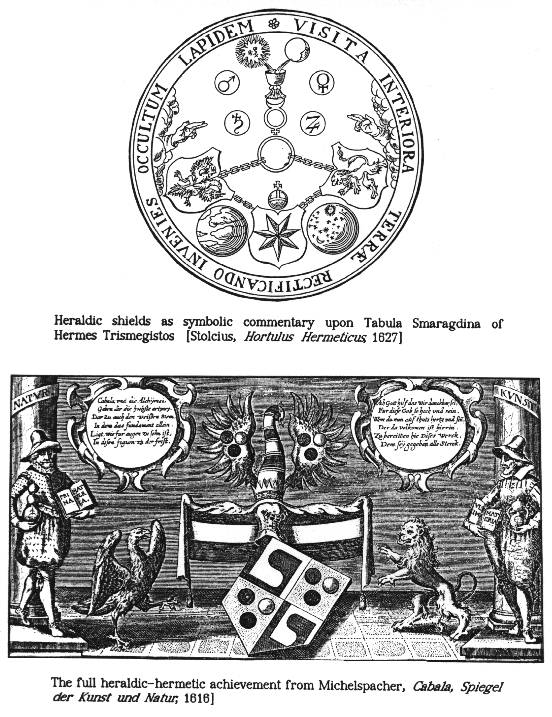
A considerable number of alchemical treatises contain what they call Arma Artis, i.e. the arms of the Art of Alchemy. That in Trismosins's Splendor Solis (British Museum MS, 1582) consists of the Sun face with three smaller faces forming the eyes and mouth on the shield and the triple crescent Moon surmounted with the Sun in the crest. The symbolism of the former clearly displays the theory of three alchemical principles - Mercury, Sulphur and Salt - as the constituents of the Philosopher's Stone, while the crest represents the Conjunctio Oppositorum of the two basic principles usually symbolized by the Sun/Moon or King/Queen duality. A later version of the same work, Le Toyson d'or (1612), contains on its title page a well known emblematic figure incorporating three heraldic shields with the double-headed eagle, lion and seven-pointed star. The same emblem was also included among the engravings of Viridarium chymicum by Daniel Stolcius (1624) as illustrating the text of the Emerald Table of Hermes. Similar theme of triplicity and duality appears in the full heraldic achievement on the first plate in Spiegel der Kunst und Natur attributed to Stephan Michelspracher (1654). The quartered shield displays in the 1st and 4th a pattern very similar to the Chinese Tao symbol and certainly representing the same idea of interpenetration of the two opposing forces (Yin and Yang, female and male, etc.). The 2nd and 3rd quarters contain three circles (or spheres), apparently in the field of golden colour (the engraving is not in colour, of course, but the pattern of dots is used in heraldry to indicate the metal of gold). The symbol is actually the same as in Splendor Solis - the three elements of which gold is made. The same basic symbolism is indicated by the crest - the duality of two wings, each of which contains the three elements. The supporters are lion and eagle, familiar alchemical symbols of the opposites or of White Gluten and Red Blood. The same three elemental circles or spheres are also present in the same quarters of the shield on the engraving of the hermaphrodite Emperor in Thurneisser's Quinta Essentia (1574). The other two quarters contain what seems to be the chess tower which might indicate intelligence or skill. The last engraving from the Mutus Liber (1702) shows a shield divided by a chevron, with the three circles over a triple hill in the bottom half and what seems to be three shells (escallops that were used as badges of pilgrims in the Middle Ages) in the upper half. This reappearance of the same pattern of three circles in symbolic heraldic designs cannot be a mere conincidence.
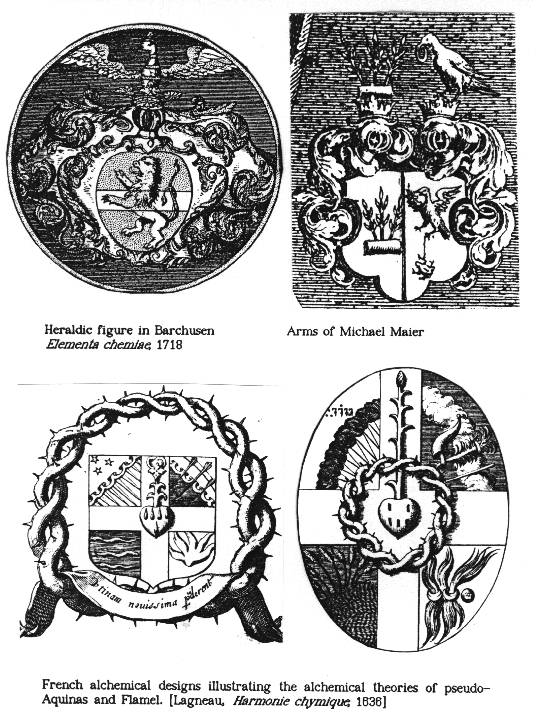
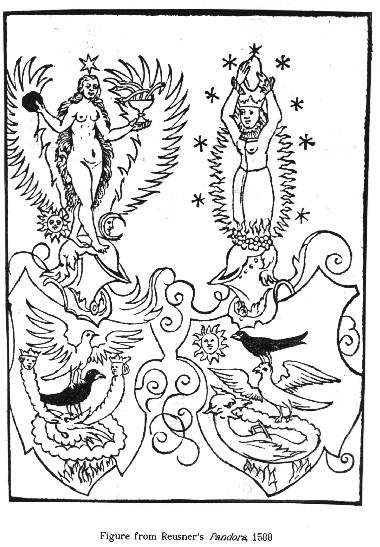
The coat-of-arms from the fourth figure in Johann Conrad Barchusen's Elementa chemiae (1718), which is an edition of much earlier treatise The Crowning of Nature (the version published by Adam McLean in the Magnum Opus series, however, does not include this figure), again shows the lion-eagle duality, this time placed respectively on the shield and in the crest. The shield has a fess across the lion, thus suggesting the triple nature of Materia Ultima or the Philosopher's Stone symbolized by it. Besides the two opposites and the three principles, alchemical theory made extensive use of the four elements of ancient philosophy: Fire, Air, Water and Earth. These can be found in "hierogliphic" arms depicting the Philosopher's Stone that were reproduced in David Lagneau's Harmonie chymique (Paris, 1636). According to the commentary they were designed on the basis of the teachings of St. Thomas Aquinas and Nicholas Flamel. The four quarters contain symbolic representations of the elements, which are not very heraldic, and in the centre is placed a heart with five drops of blood and a flower issuing from it. The symbols of blood and flower are often used in alchemy to represent the Red Tincture or "flowering" of the Great Work. The most beautiful example of hermetic arms I could find is that from a German manuscript showing the Green Dragon biting its tail and holding Red Roses in its claws, with the White Eagle and the Phoenix or Dove above it. This is a heraldicized version of a well known alchemical emblem. In modern continuation of the hermetic tradition the most outstanding example of utilizing the symbolic language of heraldry for expressing the ideas of the hermetic philosophy was the French work Heraldique alchimique nouvelle by Jorge Camacho and Alain Gruger (Paris, 1978). It contains a set of 47 coats-of-arms intended to reflect the stages of the Great Work. Unfortunately, I have not been able to see this publication. Another field for possible research are the arms of hermetic writers and philosophers. Many of these had their inherited family crests and therefore finding occult symbolism may not be possible in all cases. An example may be the coat-of-arms of Robert Fludd or Heinrich Kunrath, though the latter's arms is displayed on the engraving of his laboratory in Amphitheatrum sapientiae aeternae (1604) which may indicate that even inherited arms may have been interpreted in hermetic terms just as Christian ideas or Greek myths were. Some armigerous alchemists modified their arms so that any possible hermetic symbolism was stressed. This approach may be seen in the coat-of-arms of Michael Sendivogius which, in the Polish heraldic system, was that of the clan Ostoja and showed a sword between two crescents with a green dragon in the crest. As the Green Dragon was an important alchemical symbol, he used a quartered shield so that it also appeared on it and not only above the helmet.
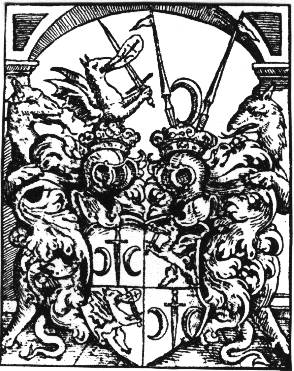
Michael Maier's arms seem to be a fusion of his hereditary crest and one with obvious hermetic symbolism divided "per pale". The latter shows an eagle above and a toad below connected with a thin thread, and a dove with a golden ring in its beak above the helmet. The toad is the symbol of Prima Materia appearing already in medieval alchemical symbolism (e.g. Ripley's Scrowle) but here may refer, together with the eagle, to the Dense and the Volatile duality. The dove with the golden ring clearly indicates the completion of the Great Work, as it is often used interchangeably with the phoenix symbol in this meaning. Some heraldic research would be necessary for classifying the arms of Johann Daniel Mylius, as it may be either inherited or adopted. This would be interesting, because it would show how one may see hermetic symbols in heraldry even if their use had not been intentional. The three fleur-de-lis on the shield may refer to the three principles of Mercury, Sulphur and Salt, while the crowned lion holding two fleur-de-lis and between two trumpets in the crest may well indicate the completion of the Magnum Opus (the Red Lion of alchemy with the Red and White Tinctures). The possibility of such interpretation is stressed by two traditional alchemical symbols appearing at the bottom of the engraving - the Pelican and the Phoenix.

An interesting, and obviously thought out, hermetic coat-of-arms is that of one Cornelius Petraeus of Hamburg from the 17th century. It shows Mercury borne down on one side by a heavy weight, refering to the fixed, and borne up on the other side by the wings attached to his hand and leg, symbolic of the volatile. One of his feet is set on land, while the other floats over the water. In the crest above there is a seven-pointed star representing seven planets and metals between two wings.
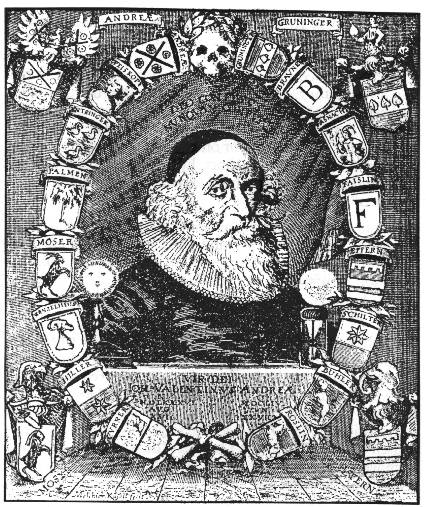
Perhaps the most famous heraldic device connected with the hermetic tradition is that of the Rosy Cross. It has been often stated that the symbol was derived from the coat-of-arms of Johann Valentin Andreae which displays an X-cross with four red roses. Another theory say it refers to the arms of Martin Luther of a rose surmounted with a cross of equal arms (though some sources state it is an apple flower). One of the numerous portraits of Andreae shows 16 coats-of-arms, presumably of his direct ancestors, which proves his preoccupation with heraldry and adds another argument for the theory that he was the real founder of the Rosicrucian Order. Whatever the truth is, the later Rosicrucian tradition always used a heraldicized rose emblem as its symbol which had also been used in much earlier alchemical tradition.
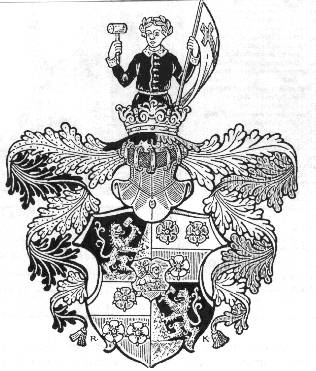
An interesting interpretation of the arms of the Schlegel family, granted to Christoph Schlegel (1613-1678), is attempted by his descendant A. Russell Slagle in Manly Palmer Hall's The Rosicrucians and Magister Christoph Schlegel (Los Angeles, 1986). Schlegel was a Protestant theologian praised by Andreae among "aetherei Spiritus zelotes" and connected with his Societas Christiana, and the arms was granted to him in 1651. The interpretation draws parallels with the symbols used in The Chemical Marriage of Christian Rosencreutz and though it seems to fit, it is not absolutely obvious that the arms is an example of hermetic symbolism. One of the most important modern continuators of the hermetic tradition, Carl Gustav Jung, in his essay "The Tower" (in Memories, Dreams, Reflexions) describes his family crest which originally displayed the Phoenix refering to the meaning of the word "jung" (young) and so being a punning arms. His grandfather, who was a Grand Master of a Swiss Masonic Lodge, changed the arms so that it reflected freemasonic symbolism. The shield was quartered and displayed a blue cross in the first quarter, a bunch of grapes in the fourth, and a golden star in the second and third. Jung himself, however, interpreted it as being Rosicrucian and while, according to him, the Cross and the Rose symbolized the Christian and the Dionisian elements, so the Cross and the Grapes symbolized the Heavenly and the Chtonic principles. The Golden Star, he says, is a symbol of Aurum Philosophorum. Jung's interpretations of alchemical symbols are always disputable and they tell one more about his system of depth psychology than about alchemy itself. In this case Rosicrucian and alchemical connections of his grandfather's arms also seem to be wishful thinking biased by his interests. The same attitude may have been taken by earlier hermetic philosophers or present interpreters of heraldic symbolism. An example of how an overenthusiastic researcher might see hermetic symbolism everywhere is the arms of a Polish town called Wejcherowo. It consists of a Maltanese cross with a red rose in the middle of it, the whole surrounded by a laurel wreath and placed on golden field. As the town was founded in 1643, shortly after the hight of the Rosicrucian storm that swept across Europe, and as it is near Gdansk (Danzig), known for Rosicrucian activities at the same time, one might conclude that it is a symbol of the Rosy Cross Order. The truth is, however, that the founder of the town, Jakub Wejcher, was a member of the Order of the Knights of Malta and had a red rose in his own family arms, so just joined both symbols to give the coat-of-arms to the newly founded town. Even though everything seems to fit, there is no hermetic symbolism involved in this case, as possibly in many others.
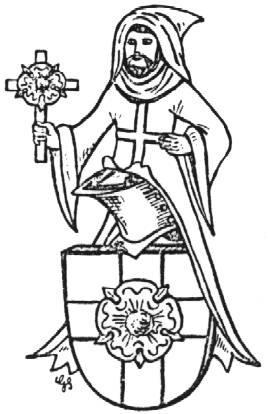
Illustrations: 1. Heraldic ordinaries 2. Heraldic eagle as an alchemical symbol 3. Eagle as spirit ascending from Prima Materia [Jung, fig.229] 4. Extraction of the spirit of Mercurius from Prima Materia. Pandora by Reusner. [Jung, fig. 232] 5. Double-headed eagle divided per pale. De Alchimia by pseudo-Aquinas [Jung, fig. 20] 6-9. Heraldic drawings from Buch der Heiligen Dreifaltigkeit 9a. The tournament fight between the Sun-Knight and the Moon-Lady from Aurora consurgens [Stanislaus Klossowski de Rola, Alchemy, fig. 13] 10. Alchemist as herald. Book of Lambspring 11. The coat-of-arms of Lambspring. 12. "Arma Artis" from Splendor Solis 13. Heraldic shields as symbolic commentary upon Tabula Smaragdina of Hermes Trismegistos [in Stolcius's Hermetic Garden - Christian Rosenkreutz Anthology by Allen] 14. The full heraldic-hermetic achievement from Miehelspracher's Cabala 15. The shield in Thurneisser's Quinta essentia 16. The arms from Mutus Liber 17. Heraldic figure in Barchusen's Elementa chemiae 18. French alchemical designs illustrating the alchemical theories of pseudo-Aquinas and Flamel 19. Heraldic-alchemical designs [in Alchemia by E.E. Ploss, H. Roosen-Runge, H. Schipperges, M.nchen 1970] 20. The arms of Michael Sendivogius 21. The arms of Michael Maier 22. The arms of J.D. Mylius 22a. Book-plate of Cornelius Petraeus [Klossowski, Alchemy, fig.52] 23. Alchemical Red Rose from Ripley's Scrowle [Jung, fig. 30] 24. Portrait of Johann Valentin Andreae surrounded by coats-of-arms [M.P.Hall, The Rosicrucians and Magister Christoph Schlegel, p. 48] 25. The arms granted to Christoph Schlegel [M.P. Hall, ibid., p. 144] |